Cybercrime and the Human Element: Future Trends and Vulnerabilities
VerifiedAdded on 2022/09/09
|6
|1299
|16
Report
AI Summary
This report examines the critical human factor in the escalating landscape of cybercrime. It explores the intertwined relationship between technology and criminal activities, emphasizing how advancements in devices, applications, and online platforms create new opportunities for malicious actors. The report highlights the vulnerabilities arising from human dependence on technology, including the exploitation of personal information on social media and the increasing reliance on interconnected systems. It discusses various types of cyberattacks, from identity theft and financial fraud to cyber-terrorism and the hacking of critical infrastructure. The report also considers the challenges faced by law enforcement in combating cybercrime, including its global scale and the need for continuous adaptation to evolving threats. Ultimately, the report underscores the urgent need for enhanced cybersecurity measures and a greater awareness of the human element in preventing and mitigating cybercrime.
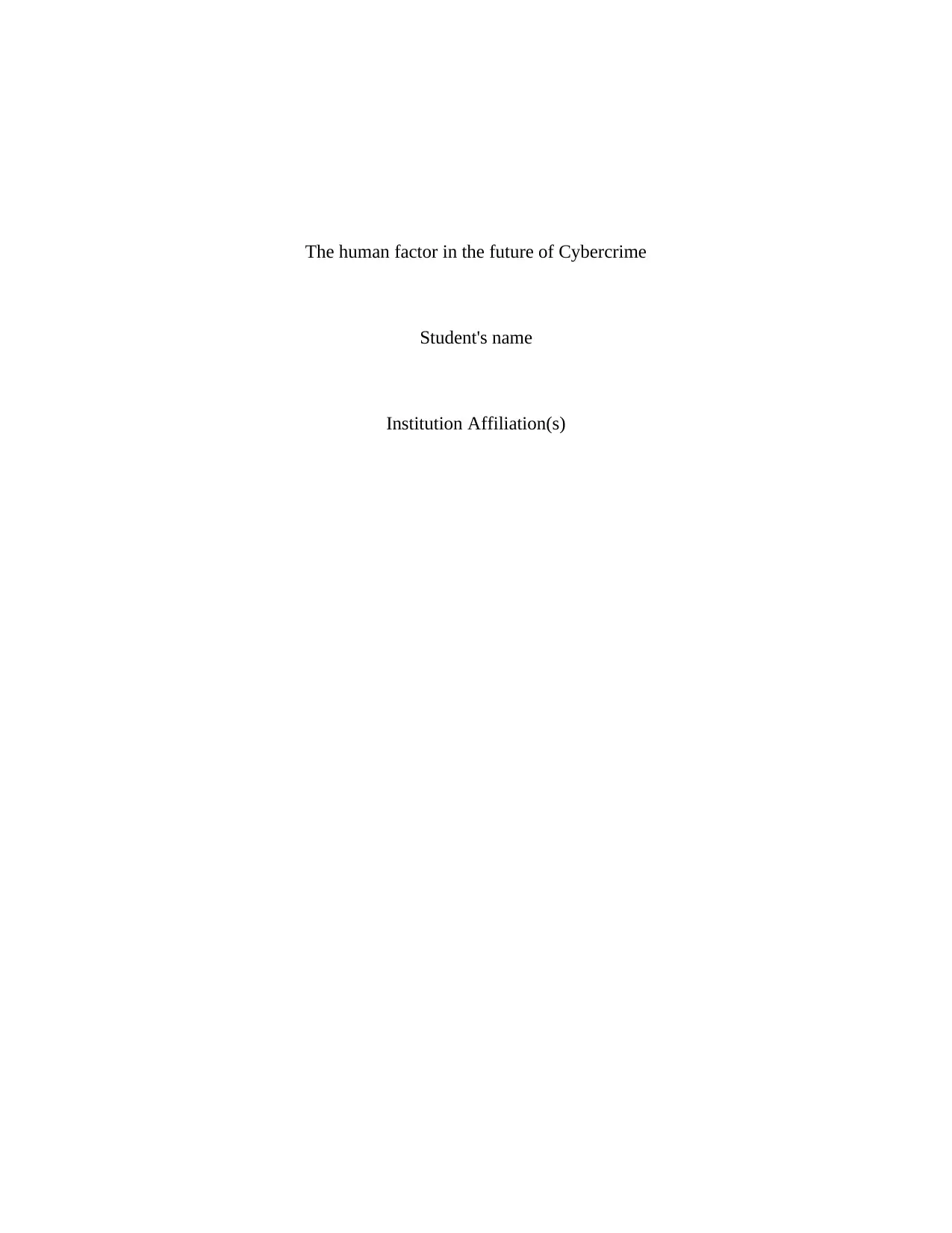
The human factor in the future of Cybercrime
Student's name
Institution Affiliation(s)
Student's name
Institution Affiliation(s)
Paraphrase This Document
Need a fresh take? Get an instant paraphrase of this document with our AI Paraphraser
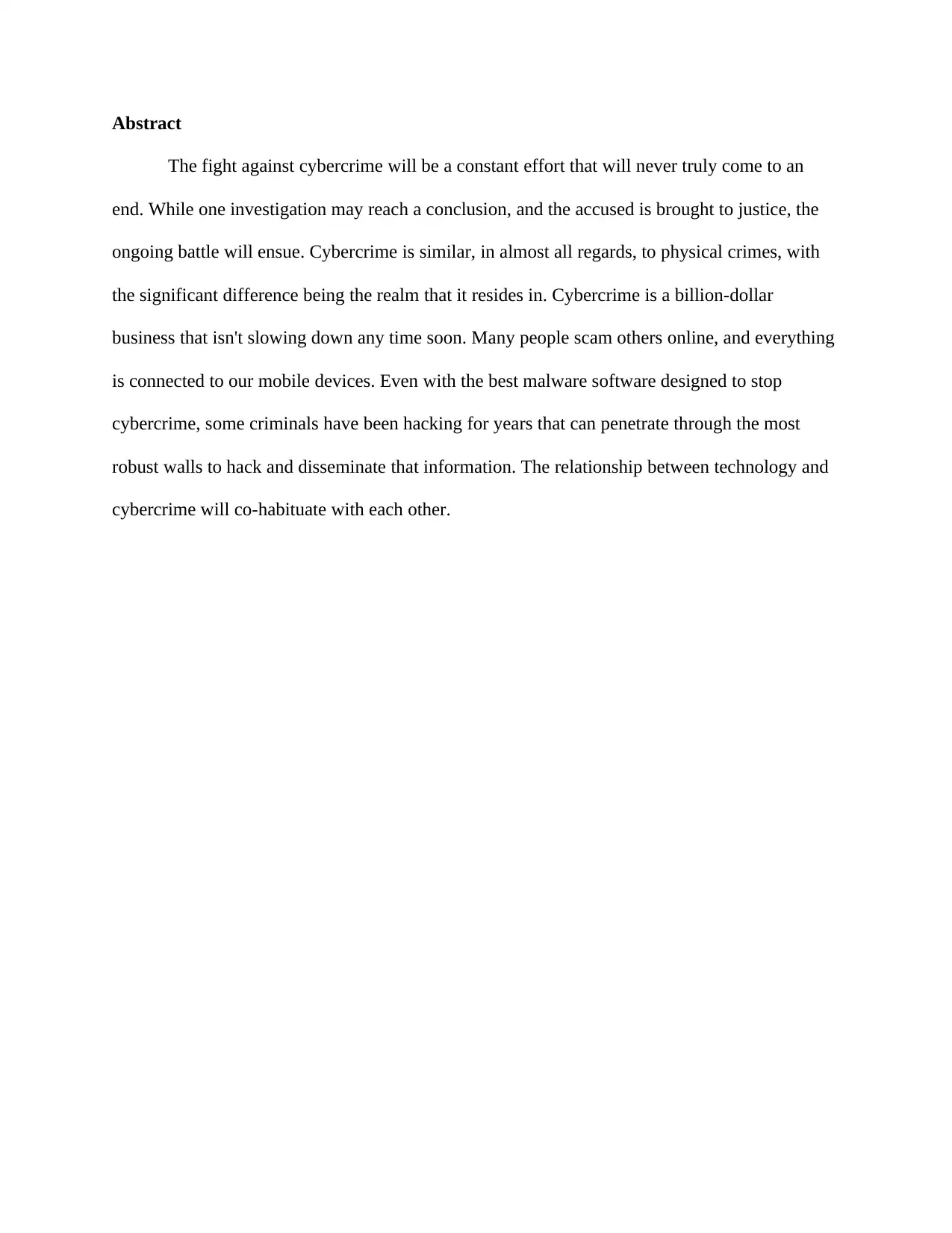
Abstract
The fight against cybercrime will be a constant effort that will never truly come to an
end. While one investigation may reach a conclusion, and the accused is brought to justice, the
ongoing battle will ensue. Cybercrime is similar, in almost all regards, to physical crimes, with
the significant difference being the realm that it resides in. Cybercrime is a billion-dollar
business that isn't slowing down any time soon. Many people scam others online, and everything
is connected to our mobile devices. Even with the best malware software designed to stop
cybercrime, some criminals have been hacking for years that can penetrate through the most
robust walls to hack and disseminate that information. The relationship between technology and
cybercrime will co-habituate with each other.
The fight against cybercrime will be a constant effort that will never truly come to an
end. While one investigation may reach a conclusion, and the accused is brought to justice, the
ongoing battle will ensue. Cybercrime is similar, in almost all regards, to physical crimes, with
the significant difference being the realm that it resides in. Cybercrime is a billion-dollar
business that isn't slowing down any time soon. Many people scam others online, and everything
is connected to our mobile devices. Even with the best malware software designed to stop
cybercrime, some criminals have been hacking for years that can penetrate through the most
robust walls to hack and disseminate that information. The relationship between technology and
cybercrime will co-habituate with each other.
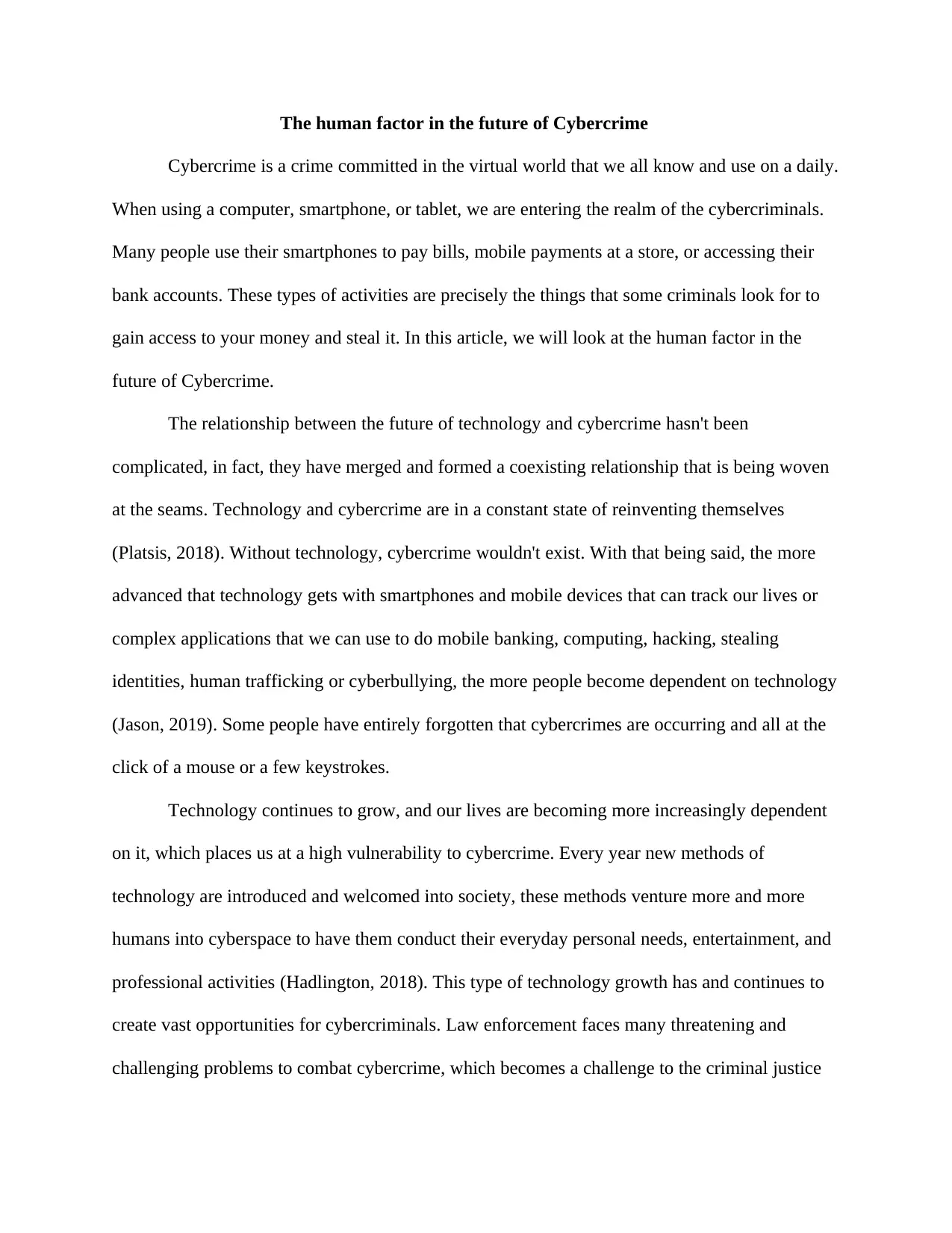
The human factor in the future of Cybercrime
Cybercrime is a crime committed in the virtual world that we all know and use on a daily.
When using a computer, smartphone, or tablet, we are entering the realm of the cybercriminals.
Many people use their smartphones to pay bills, mobile payments at a store, or accessing their
bank accounts. These types of activities are precisely the things that some criminals look for to
gain access to your money and steal it. In this article, we will look at the human factor in the
future of Cybercrime.
The relationship between the future of technology and cybercrime hasn't been
complicated, in fact, they have merged and formed a coexisting relationship that is being woven
at the seams. Technology and cybercrime are in a constant state of reinventing themselves
(Platsis, 2018). Without technology, cybercrime wouldn't exist. With that being said, the more
advanced that technology gets with smartphones and mobile devices that can track our lives or
complex applications that we can use to do mobile banking, computing, hacking, stealing
identities, human trafficking or cyberbullying, the more people become dependent on technology
(Jason, 2019). Some people have entirely forgotten that cybercrimes are occurring and all at the
click of a mouse or a few keystrokes.
Technology continues to grow, and our lives are becoming more increasingly dependent
on it, which places us at a high vulnerability to cybercrime. Every year new methods of
technology are introduced and welcomed into society, these methods venture more and more
humans into cyberspace to have them conduct their everyday personal needs, entertainment, and
professional activities (Hadlington, 2018). This type of technology growth has and continues to
create vast opportunities for cybercriminals. Law enforcement faces many threatening and
challenging problems to combat cybercrime, which becomes a challenge to the criminal justice
Cybercrime is a crime committed in the virtual world that we all know and use on a daily.
When using a computer, smartphone, or tablet, we are entering the realm of the cybercriminals.
Many people use their smartphones to pay bills, mobile payments at a store, or accessing their
bank accounts. These types of activities are precisely the things that some criminals look for to
gain access to your money and steal it. In this article, we will look at the human factor in the
future of Cybercrime.
The relationship between the future of technology and cybercrime hasn't been
complicated, in fact, they have merged and formed a coexisting relationship that is being woven
at the seams. Technology and cybercrime are in a constant state of reinventing themselves
(Platsis, 2018). Without technology, cybercrime wouldn't exist. With that being said, the more
advanced that technology gets with smartphones and mobile devices that can track our lives or
complex applications that we can use to do mobile banking, computing, hacking, stealing
identities, human trafficking or cyberbullying, the more people become dependent on technology
(Jason, 2019). Some people have entirely forgotten that cybercrimes are occurring and all at the
click of a mouse or a few keystrokes.
Technology continues to grow, and our lives are becoming more increasingly dependent
on it, which places us at a high vulnerability to cybercrime. Every year new methods of
technology are introduced and welcomed into society, these methods venture more and more
humans into cyberspace to have them conduct their everyday personal needs, entertainment, and
professional activities (Hadlington, 2018). This type of technology growth has and continues to
create vast opportunities for cybercriminals. Law enforcement faces many threatening and
challenging problems to combat cybercrime, which becomes a challenge to the criminal justice
⊘ This is a preview!⊘
Do you want full access?
Subscribe today to unlock all pages.

Trusted by 1+ million students worldwide
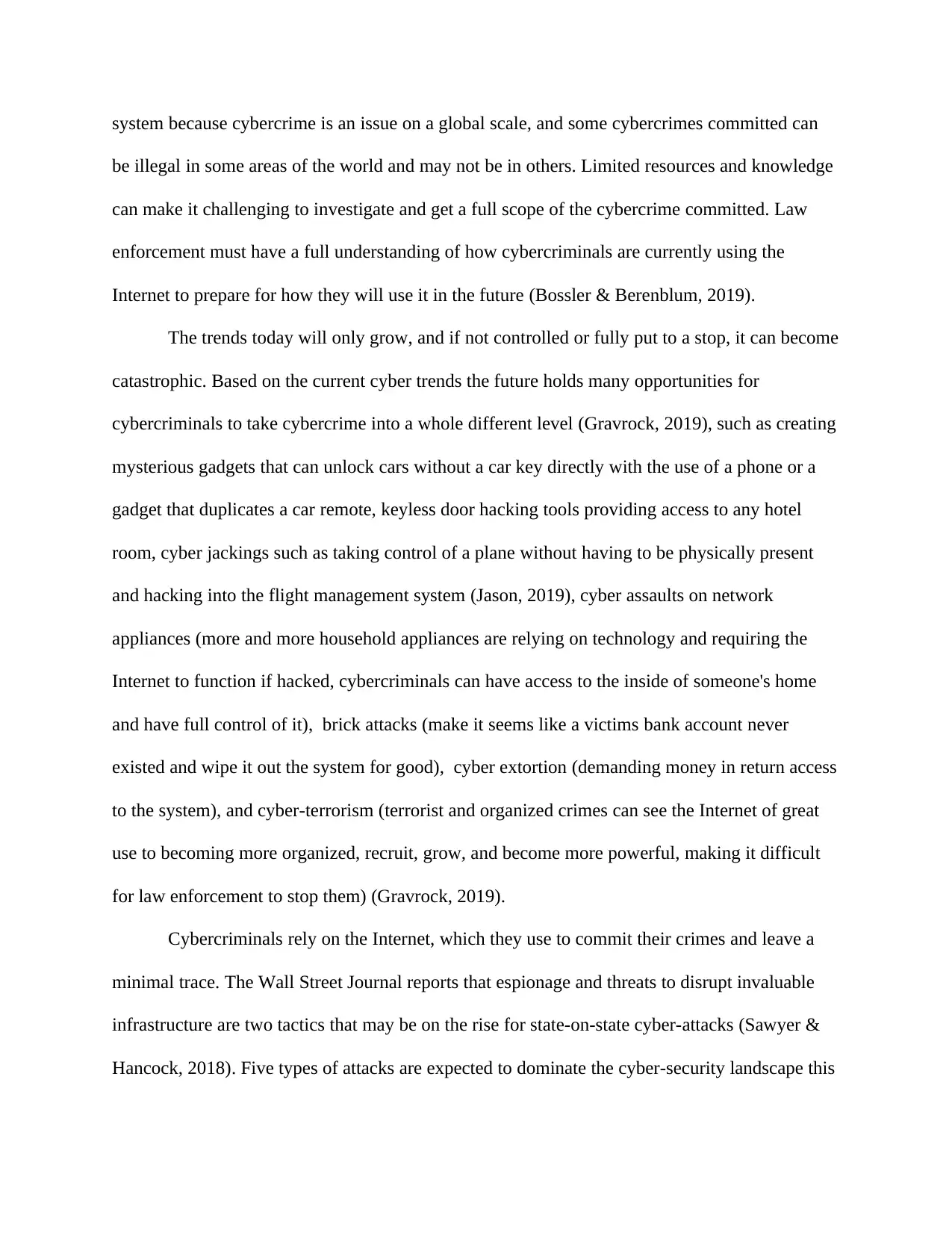
system because cybercrime is an issue on a global scale, and some cybercrimes committed can
be illegal in some areas of the world and may not be in others. Limited resources and knowledge
can make it challenging to investigate and get a full scope of the cybercrime committed. Law
enforcement must have a full understanding of how cybercriminals are currently using the
Internet to prepare for how they will use it in the future (Bossler & Berenblum, 2019).
The trends today will only grow, and if not controlled or fully put to a stop, it can become
catastrophic. Based on the current cyber trends the future holds many opportunities for
cybercriminals to take cybercrime into a whole different level (Gravrock, 2019), such as creating
mysterious gadgets that can unlock cars without a car key directly with the use of a phone or a
gadget that duplicates a car remote, keyless door hacking tools providing access to any hotel
room, cyber jackings such as taking control of a plane without having to be physically present
and hacking into the flight management system (Jason, 2019), cyber assaults on network
appliances (more and more household appliances are relying on technology and requiring the
Internet to function if hacked, cybercriminals can have access to the inside of someone's home
and have full control of it), brick attacks (make it seems like a victims bank account never
existed and wipe it out the system for good), cyber extortion (demanding money in return access
to the system), and cyber-terrorism (terrorist and organized crimes can see the Internet of great
use to becoming more organized, recruit, grow, and become more powerful, making it difficult
for law enforcement to stop them) (Gravrock, 2019).
Cybercriminals rely on the Internet, which they use to commit their crimes and leave a
minimal trace. The Wall Street Journal reports that espionage and threats to disrupt invaluable
infrastructure are two tactics that may be on the rise for state-on-state cyber-attacks (Sawyer &
Hancock, 2018). Five types of attacks are expected to dominate the cyber-security landscape this
be illegal in some areas of the world and may not be in others. Limited resources and knowledge
can make it challenging to investigate and get a full scope of the cybercrime committed. Law
enforcement must have a full understanding of how cybercriminals are currently using the
Internet to prepare for how they will use it in the future (Bossler & Berenblum, 2019).
The trends today will only grow, and if not controlled or fully put to a stop, it can become
catastrophic. Based on the current cyber trends the future holds many opportunities for
cybercriminals to take cybercrime into a whole different level (Gravrock, 2019), such as creating
mysterious gadgets that can unlock cars without a car key directly with the use of a phone or a
gadget that duplicates a car remote, keyless door hacking tools providing access to any hotel
room, cyber jackings such as taking control of a plane without having to be physically present
and hacking into the flight management system (Jason, 2019), cyber assaults on network
appliances (more and more household appliances are relying on technology and requiring the
Internet to function if hacked, cybercriminals can have access to the inside of someone's home
and have full control of it), brick attacks (make it seems like a victims bank account never
existed and wipe it out the system for good), cyber extortion (demanding money in return access
to the system), and cyber-terrorism (terrorist and organized crimes can see the Internet of great
use to becoming more organized, recruit, grow, and become more powerful, making it difficult
for law enforcement to stop them) (Gravrock, 2019).
Cybercriminals rely on the Internet, which they use to commit their crimes and leave a
minimal trace. The Wall Street Journal reports that espionage and threats to disrupt invaluable
infrastructure are two tactics that may be on the rise for state-on-state cyber-attacks (Sawyer &
Hancock, 2018). Five types of attacks are expected to dominate the cyber-security landscape this
Paraphrase This Document
Need a fresh take? Get an instant paraphrase of this document with our AI Paraphraser
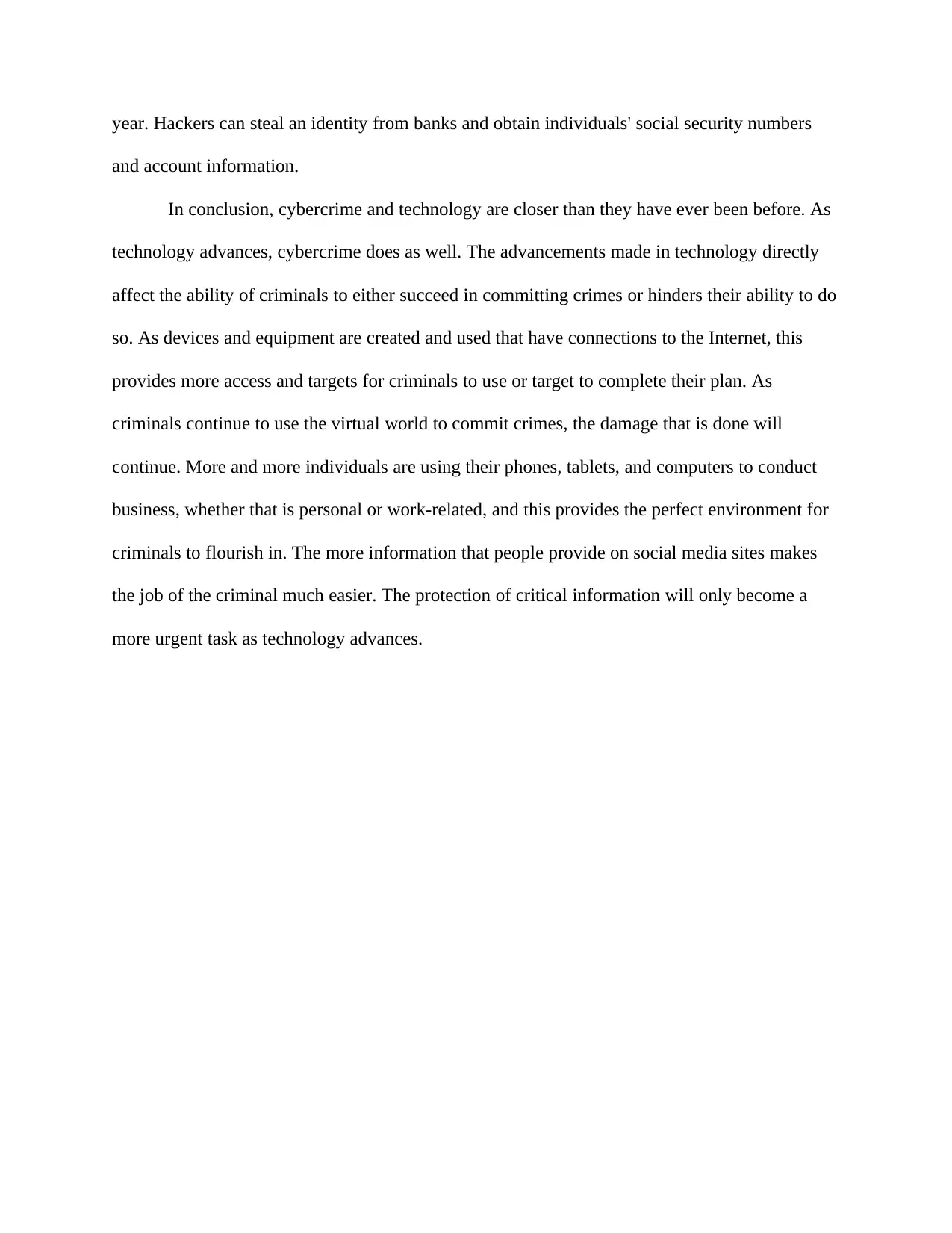
year. Hackers can steal an identity from banks and obtain individuals' social security numbers
and account information.
In conclusion, cybercrime and technology are closer than they have ever been before. As
technology advances, cybercrime does as well. The advancements made in technology directly
affect the ability of criminals to either succeed in committing crimes or hinders their ability to do
so. As devices and equipment are created and used that have connections to the Internet, this
provides more access and targets for criminals to use or target to complete their plan. As
criminals continue to use the virtual world to commit crimes, the damage that is done will
continue. More and more individuals are using their phones, tablets, and computers to conduct
business, whether that is personal or work-related, and this provides the perfect environment for
criminals to flourish in. The more information that people provide on social media sites makes
the job of the criminal much easier. The protection of critical information will only become a
more urgent task as technology advances.
and account information.
In conclusion, cybercrime and technology are closer than they have ever been before. As
technology advances, cybercrime does as well. The advancements made in technology directly
affect the ability of criminals to either succeed in committing crimes or hinders their ability to do
so. As devices and equipment are created and used that have connections to the Internet, this
provides more access and targets for criminals to use or target to complete their plan. As
criminals continue to use the virtual world to commit crimes, the damage that is done will
continue. More and more individuals are using their phones, tablets, and computers to conduct
business, whether that is personal or work-related, and this provides the perfect environment for
criminals to flourish in. The more information that people provide on social media sites makes
the job of the criminal much easier. The protection of critical information will only become a
more urgent task as technology advances.
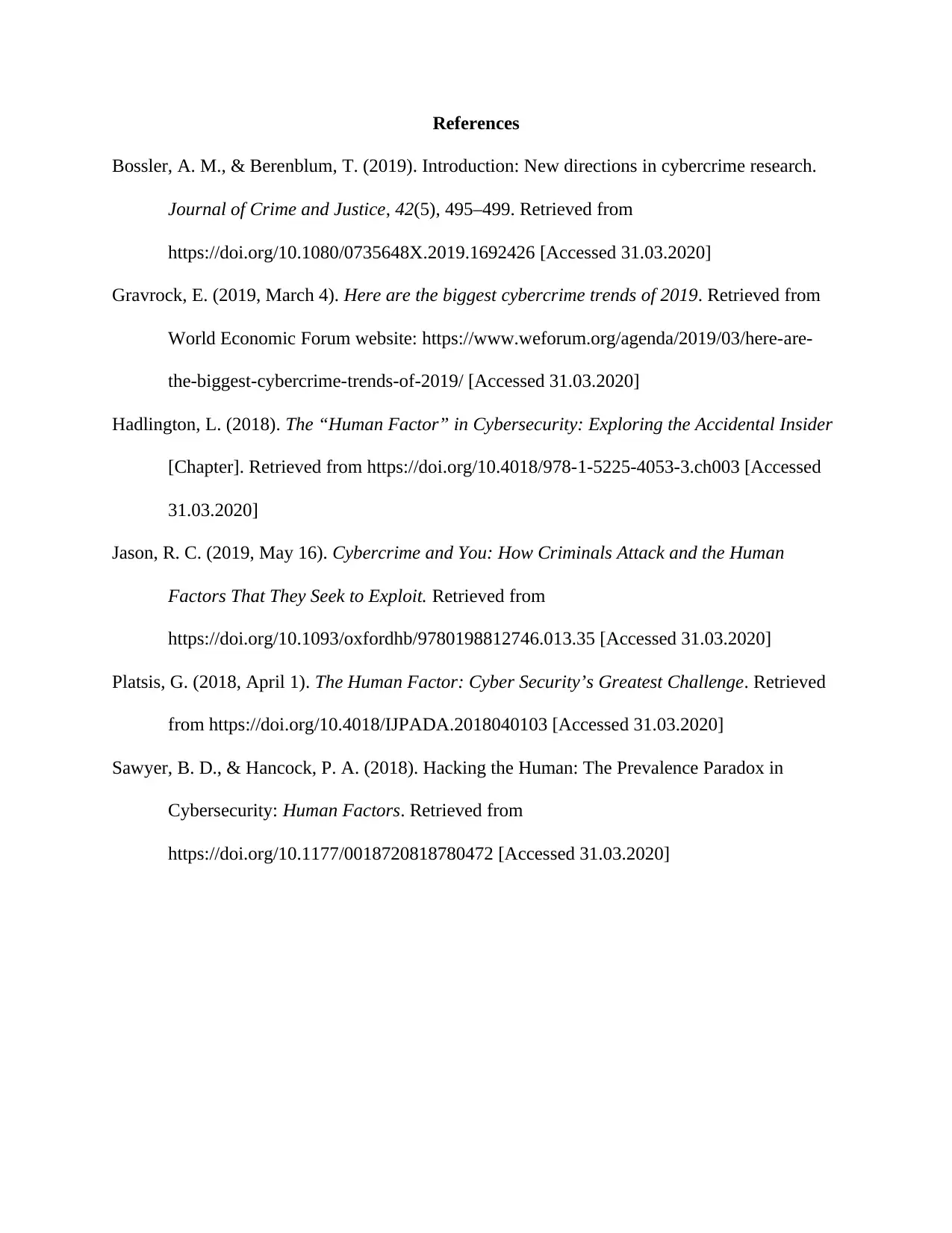
References
Bossler, A. M., & Berenblum, T. (2019). Introduction: New directions in cybercrime research.
Journal of Crime and Justice, 42(5), 495–499. Retrieved from
https://doi.org/10.1080/0735648X.2019.1692426 [Accessed 31.03.2020]
Gravrock, E. (2019, March 4). Here are the biggest cybercrime trends of 2019. Retrieved from
World Economic Forum website: https://www.weforum.org/agenda/2019/03/here-are-
the-biggest-cybercrime-trends-of-2019/ [Accessed 31.03.2020]
Hadlington, L. (2018). The “Human Factor” in Cybersecurity: Exploring the Accidental Insider
[Chapter]. Retrieved from https://doi.org/10.4018/978-1-5225-4053-3.ch003 [Accessed
31.03.2020]
Jason, R. C. (2019, May 16). Cybercrime and You: How Criminals Attack and the Human
Factors That They Seek to Exploit. Retrieved from
https://doi.org/10.1093/oxfordhb/9780198812746.013.35 [Accessed 31.03.2020]
Platsis, G. (2018, April 1). The Human Factor: Cyber Security’s Greatest Challenge. Retrieved
from https://doi.org/10.4018/IJPADA.2018040103 [Accessed 31.03.2020]
Sawyer, B. D., & Hancock, P. A. (2018). Hacking the Human: The Prevalence Paradox in
Cybersecurity: Human Factors. Retrieved from
https://doi.org/10.1177/0018720818780472 [Accessed 31.03.2020]
Bossler, A. M., & Berenblum, T. (2019). Introduction: New directions in cybercrime research.
Journal of Crime and Justice, 42(5), 495–499. Retrieved from
https://doi.org/10.1080/0735648X.2019.1692426 [Accessed 31.03.2020]
Gravrock, E. (2019, March 4). Here are the biggest cybercrime trends of 2019. Retrieved from
World Economic Forum website: https://www.weforum.org/agenda/2019/03/here-are-
the-biggest-cybercrime-trends-of-2019/ [Accessed 31.03.2020]
Hadlington, L. (2018). The “Human Factor” in Cybersecurity: Exploring the Accidental Insider
[Chapter]. Retrieved from https://doi.org/10.4018/978-1-5225-4053-3.ch003 [Accessed
31.03.2020]
Jason, R. C. (2019, May 16). Cybercrime and You: How Criminals Attack and the Human
Factors That They Seek to Exploit. Retrieved from
https://doi.org/10.1093/oxfordhb/9780198812746.013.35 [Accessed 31.03.2020]
Platsis, G. (2018, April 1). The Human Factor: Cyber Security’s Greatest Challenge. Retrieved
from https://doi.org/10.4018/IJPADA.2018040103 [Accessed 31.03.2020]
Sawyer, B. D., & Hancock, P. A. (2018). Hacking the Human: The Prevalence Paradox in
Cybersecurity: Human Factors. Retrieved from
https://doi.org/10.1177/0018720818780472 [Accessed 31.03.2020]
⊘ This is a preview!⊘
Do you want full access?
Subscribe today to unlock all pages.

Trusted by 1+ million students worldwide
1 out of 6
Related Documents
Your All-in-One AI-Powered Toolkit for Academic Success.
+13062052269
info@desklib.com
Available 24*7 on WhatsApp / Email
![[object Object]](/_next/static/media/star-bottom.7253800d.svg)
Unlock your academic potential
Copyright © 2020–2025 A2Z Services. All Rights Reserved. Developed and managed by ZUCOL.





